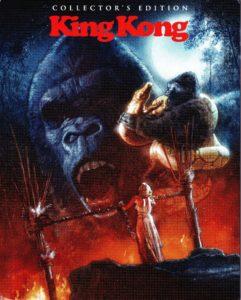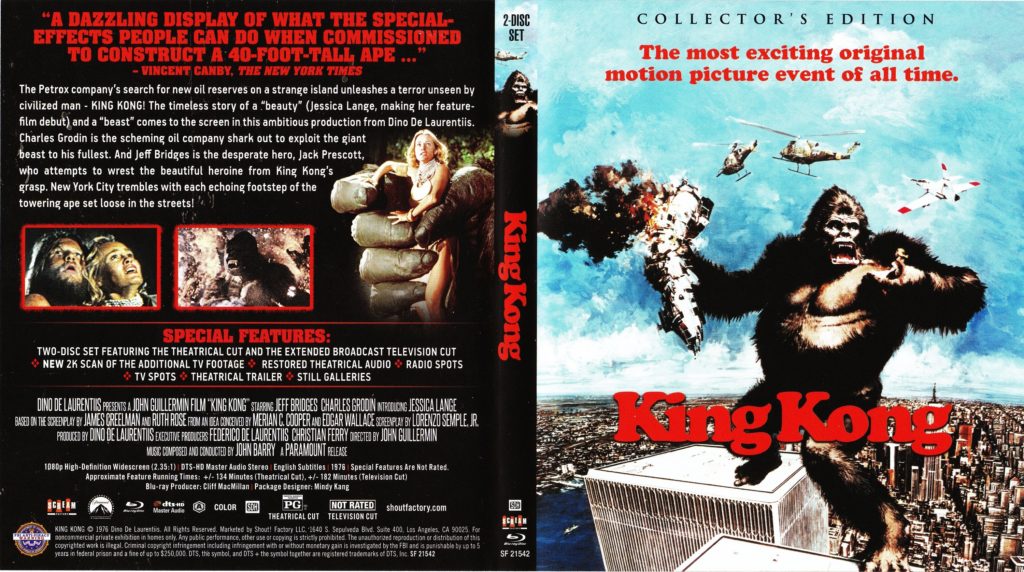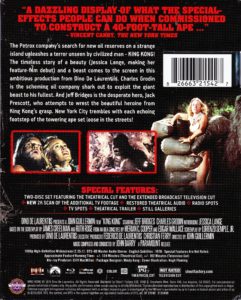 The 1976 film King Kong is a remake of the classic 1933 movie of the same name. The major story beats are similar to the original movie, but the 1976 film has a more modern setting. The Petrox Corporation is feeling the pressure from its competitors like Exxon, and is in desperate need of a new source of petroleum. Fred Wilson (Charles Grodin) thinks he has found the answer, and arranges an expedition to a mysterious, perpetually fog-covered island off the coast of Surabaya, Indonesia, in an area of the ocean known as the Magic Circle. However, unbeknownst to Wilson, in addition to Captain Ross (John Randolph), Chief Officer Carnahan (Ed Lauter), head scientist Roy Bagley (Rene Auberjonois), and the rest of the able-bodied crew, his tanker also has a stowaway—Jack Prescott, a professor from the Princeton Department of Primate Paleontology. Jack believes there is more to this island than just oil, and is eager to check it out. However, it’s not long before Jack is discovered, and put to work. During the voyage, the Petrox Explorer receives a mayday call, and comes across a raft containing a beautiful young woman named Dwan (Jessica Lange). Dwan is an aspiring starlet who was on a private yacht to Singapore to star in her first movie when her ship caught fire. She appears to be the only passenger to have survived, and Wilson welcomes her aboard, assigning Jack to watch over her—something both Dwan and Jack have no issues with.
The 1976 film King Kong is a remake of the classic 1933 movie of the same name. The major story beats are similar to the original movie, but the 1976 film has a more modern setting. The Petrox Corporation is feeling the pressure from its competitors like Exxon, and is in desperate need of a new source of petroleum. Fred Wilson (Charles Grodin) thinks he has found the answer, and arranges an expedition to a mysterious, perpetually fog-covered island off the coast of Surabaya, Indonesia, in an area of the ocean known as the Magic Circle. However, unbeknownst to Wilson, in addition to Captain Ross (John Randolph), Chief Officer Carnahan (Ed Lauter), head scientist Roy Bagley (Rene Auberjonois), and the rest of the able-bodied crew, his tanker also has a stowaway—Jack Prescott, a professor from the Princeton Department of Primate Paleontology. Jack believes there is more to this island than just oil, and is eager to check it out. However, it’s not long before Jack is discovered, and put to work. During the voyage, the Petrox Explorer receives a mayday call, and comes across a raft containing a beautiful young woman named Dwan (Jessica Lange). Dwan is an aspiring starlet who was on a private yacht to Singapore to star in her first movie when her ship caught fire. She appears to be the only passenger to have survived, and Wilson welcomes her aboard, assigning Jack to watch over her—something both Dwan and Jack have no issues with.
Once the ship arrives at its mysterious destination, Wilson makes Jack the official photographer for the expedition, and takes a small party ashore to investigate. While Wilson believed the island to be uninhabited, they soon discover a massive man-made wall, and a gathering of indigenous people carrying out some sort of ritualistic ceremony to a god-like colossal ape they call Kong. The natives don’t appreciate the interruption from the explorers, and soon make Dwan a part of their sacrificial ritual. However, once Kong sets his eyes on Dwan, it is love at first site, and he wants her as his bride. The feeling, of course, is not mutual. So as Jack and the others embark on a rescue mission, Wilson comes up with his own lucrative plan involving the massive 40-foot ape. What could go wrong?!
Shout! Factory’s new two-disc Collector’s Edition Blu-ray includes two versions of the film—both the theatrical cut of the movie, as well as the extended television cut, which runs about an hour longer. However, the latter truly is an extended version, with just more footage added to each scene, without really introducing any new story arcs or any major story differences. But more on that in a bit.
At its core, King Kong is part monster movie, part tragic Beauty and the Beast-like love story. The first act of the film finds this expedition on their way to this mysterious island. In charge of the operation is the ruthless company man who is used to being behind a desk. His main concern is making money and proving himself to those in charge in order to be promoted. Along the way his expedition picks up two new passengers. The first is the more altruistic professor who has a love for and understanding of animals, and a concern for the inhabitants of the island. When the ship picks up Dwan, Jack is immediately smitten with this wild young actress, and the feeling is mutual. Dwan was eager and willing to do whatever it took to be a star, and loves the attention she now gets from the men on the boat. She sees her chance to once again be in the spotlight, and eagerly volunteers to join the team as they head off to explore the island for the first time. However, once the group gets to the island, it’s the typical story of foreigners coming in and feeling like they know better than the indigenous people. They want to stop what they see as a “barbaric” ritual, and stake their claim to any oil they can find on these strangers’ land. Wilson even disgustingly refers to the indigenous people as “wogs”.
In the second act, we finally meet Kong as he sets his eyes on his new prize. Dwan does what anyone would do in her situation—she screams and tries to get away. However, she soon realizes that this massive creature is holding her captive out of love, and would actually put himself in harm’s way to protect her. But the others just see Kong as a monster, and the ever-charming Wilson even tries to stir up hate for the ape by claiming that Kong tried to rape Dwan. (This is pretty much the only scene that makes this film a little less family-friendly.) And the final act finds everyone headed back to New York City where Kong is to be used as a form of entertainment. But Wilson should have known better than to try to control such a massive creature. Kong, scared and in an unknown new world, goes on a rampage of destruction in search of his lost love, Dwan. Unlike the 1933 film, which culminates at the Empire State Building, this version uses the newly-built (at the time) World Trade Center as its big final set piece.
King Kong marks Jessica Lange’s feature film debut, and she’s quite good in her first big role. She not only delivers on the more wild, party girl and ambitious actress side of Dwan, but also conveys this real affection and caring both for Jack and eventually for Kong. There is palpable emotion in her performance. Jeff Bridges has great on-screen chemistry with Lange, and takes on more of the action hero type role in the movie. And Charles Grodin plays despicable quite well, but not in a cartoony moustache-twirling kind of way. Wilson starts off as this seemingly-normal and friendly businessman, but as the film progresses, you get more of a sense of his ruthlessness. While the depiction of Kong takes several forms, from giant mechanical set pieces to an actor in an ape suit, it is latter (performed by the amazing Rick Baker), that you really get a sense of the heart and humanity in what would otherwise be a massive scary beast. However, I must admit that in a couple scenes, Kong’s beady eyes staring at Dwan come off a little creepy and lecherous rather than romantic. And by the final act of the film, Kong becomes almost campy and comical, with the film turning into a Godzilla-like monster movie, as Kong smashes his way through New York City, destroying buildings and throwing people from trains. This can be a bit over-the-top at times, but I thought that it added a bit of fun and excitement to close out the film.
Shout! Factory’s release includes the extended TV cut of the film, which starts off with the following disclaimer:
When the TV version of KING KING was created, the editor reused some shots, which wasn’t noticeable on TV since the film was cropped to a 1.33 aspect ratio. We chose to present the film in its 2.35:1 aspect ratio and to not crop these scenes. Consequently, you’ll notice a few sequences where characters speak but there is no dialogue. The audio isn’t missing — they weren’t meant to be visible. There are other instances where audio sync is loose, but in the absence of separate dialogue, music and effects tracks, these areas could not be adjusted.
Our new version matches the original tape master from the TV broadcast in Paramount’s vaults. We used the best available elements — sound and picture. We hope you enjoy this presentation of the longer cut of KING KONG.
This cut is broken into two halves, “Night One” and “Night Two”, which can be played separately or back-to-back. The TV cut includes several fades to black, where ads would have been inserted, and there is about 10 minutes at the start of “Night Two” that just recaps “Night One”. It would have been nice if this recap was skipped when selecting Play All. While I found the extended cut quite enjoyable overall, the theatrical cut is much faster paced, tighter, and my preferred version and the one I’ll go back to watch again in the future. The extended cut doesn’t add any new story but instead just makes all of the scenes longer, such as five more minutes of Kong banging on the fence before he breaks through. A lot of this extra footage just feels needlessly repetitive and drawn out—in this cut, it takes an additional 20 minutes before Kong even appears for the first time. Also, the fades for commercials are a bit distracting and abrupt.
The video presentation on this Blu-ray looks astonishing for a movie of this age. The picture has a pleasant amount of film grain, but otherwise looks quite clean, with black blacks and beautiful colors, and a strong level of detail. I never would have guessed this film was 45 years old—it often looks just as crisp as a modern day film. The place where the age is evident is in some of the effects. A lot of the film’s visual effects were done with blue screen composite shots using matte paintings, and sometimes the colors don’t quite line up. There was only one brief scene in the theatrical cut where I found this a bit jarring—as Jack is hiding in a cave and Kong is swiping at him, it looks like Jack has obviously been superimposed into the scene as the background black is more grey. Other scenes where a giant mechanical Kong hand is interacting and holding Dwan actually look quite good, with the edges blended in nicely. Though, there are a few scenes that go back and forth between two angles of Kong holding Dwan (switching between the two characters’ perspectives) where the time of day seems off—one perspective is brighter like it’s daytime while the other is darker like it’s nighttime. However, these are short and didn’t effect my overall enjoyment of the film. While the extended TV footage comes from a brand new 2K scan of the internegative, I found that it was often these new scenes where the special effects were more obvious, less blended, and more noticeable. I’m sure when this aired on TV back in the day it was far less noticeable in the lower resolution. However, the film’s overall use of practical effects adds to its charm, especially where everything today seems to rely on CGI.
The extended cut of the film is only presented with a stereo soundtrack, while the theatrical cut also offers a 5.1 surround track. In both versions, the dialogue is primarily located in the center channel, where it remains clear and understandable throughout. However the surround sound track on the theatrical cut offers a bit richer and fuller sound. The score feels a bit more filled out, and the bass a little more emphasized, especially as Kong roars and goes “ape” in the city.
Like many of Shout! Factory’s Collector’s Edition Blu-rays, this one is loaded with brand new bonus material, starting off with two new commentary tracks. The first is by film historian Ray Morton, and the second is a feature-length audio interview with the iconic Rick Baker. The release also includes 50 minutes of brand-new interviews with cast and crew members, a 70-minute panel discussion on the film from 2016, as well as trailers, TV and radio spots, and image galleries.
Each cut of the film resides on its own disc, which are placed on either side of a standard Blu-ray keepcase with a slipcover. The case insert is reversible, giving the viewer a choice of cover art. The default view matches the slipcover artwork, and the alternate view can be seen below:
What’s Included:
- Theatrical Cut (2:14:29)
- 1080p / Widescreen 2.35:1
- Audio: English 5.1 DTS-HD Master Audio Surround, 2.0 English DTS-HD Master Audio Stereo
- Subtitles: English SDH
- TV Cut (3:13:21)
- “Night One” (1:35:24), “Night Two” (1:37:27)
- 1080p / Widescreen 2.35:1
- Audio: English 2.0 DTS-HD Master Audio Stereo
- Subtitles: English SDH
Extras:
- DISC 1: Theatrical Cut
Nearly all of the bonus material on this disc is brand new for this release, except for the trailers, TV and radio spots, and photo galleries.- Commentary by Ray Morton (2:14:29)
Film historian Ray Morton (author of King Kong: The History of a Movie Icon) provides an interesting and informative commentary, giving lots of trivia about the production and its stars/filmmakers as well as the film franchise in general. Sometimes the narration comes off a bit pre-prepared as he reads off statements and facts. However, I still found the commentary to be quite entertaining and interesting. - Commentary by Rick Baker (2:14:29)
Justin Beahm of Reverend Entertainment/Shout! Factory interviews special makeup effects wizard Rick Baker about his experience working on the film, and his love of movie-making in general. This was originally intended to be a video interview, but it went so long that it has been repurposed as a commentary track instead. As such, the discussion isn’t specifically related to what is happening on screen, and there are some breaks in the conversation, but is a really fascinating interview, and Baker shares lots of interesting stories. - On the Top of the World — Brian Frankish and David McGiffert on King Kong (11:54)
Production manager Brian Frankish and assistant director David McGiffert sit down together to discuss how they got involved with the film, shooting in Hawaii, the different incarnations of the monkey, some of the dangerous situations on set, and more. Brian Frankish also shows off some of the film’s original storyboards. - When the Monkey Dies Everybody Cries — Jeffrey Chernov and Scott Thaler on King Kong (13:48)
Production assistants Jeffrey Chernov and Scott Thaler skype in from their homes to discuss how they got involved with the film, share stories from their roles as “messengers” for the movie, and talk about how the experience gave them a crash course in filmmaking. They also discuss some of the dangerous things that happened during the shoot (this seems to be a common theme in these interviews!)—such as the giant Kong leaking hydraulic fluid and the mechanical hand nearly crushing Jessica Lange—as well as transporting the giant Kong from Italy, some money-making scams they pulled while in Italy, and more. Includes some clips and behind-the-scenes shots and footage. - Maybe in their Wildest Dreams — Sculptor Steve Varner on King Kong (5:36)
In a remote interview, sculptor Steve Varner discusses the work he did for the film, building the giant mechanical and foam Kongs. Includes some behind-the-scenes photos. - Something’s Haywire — Jack O’Halloranon King Kong (5:52)
In this skype interview, actor Jack O’Halloran (“Joe Perko”) shares some behind-the-scenes stories about his time on the film’s various sets, working with Charles Grodin, and more. The video quality of his Skype connection was horrible, so he only appears on screen for a few seconds before footage from the film is displayed over the audio interview. - From Space to Apes — Photographic Effects Assistant Barry Nolan on King Kong (5:36)
In this skype interview, photographic effects assistant Barry Nolan talks about how he got involved with the film, how the visual effects were done, and some of the technology he came up with to help view the blue screen composite shots live on set. He frankly admits that, by today’s standards, the quality of some of the visual effects “suck”. - There’s A Fog Bank Out There — Second Unit Director William Kronick on King Kong (6:31)
Second unit director William Kronick talks about how he got involved with the film and filming Jessica Lange’s screen test. He also shares his memories about filming several specific scenes, both in the rough ocean waters and at several New York City landmarks. Includes some behind-the-scenes shots and footage. - Theatrical Trailer (5:02)
Two trailers play back-to-back. - TV Spots (3:36)
Collection of seven 15- and 30-second TV spots advertising the theatrical release play back-to-back. - Radio Spots (1:35)
Collection of three 30-second radio spots advertising the theatrical release play back-to-back. - Image Galleries
Slideshows of still photos auto-advance every 4-5 seconds. Select from:- Movie Stills (7:26)
- Posters and Lobby Cards (8:53)
- Behind the Scenes (6:39)
- Newspaper Ads (3:58)
- Commentary by Ray Morton (2:14:29)
- DISC 2: Extended TV Broadcast Cut
- King Kong Panel Discussion From The Aero Theater (1:08:45)
This Q&A with cast members and filmmakers was originally recorded on December 10, 2016 at the Aero Theater in Santa Monica, CA. The panel is moderated by film historian Ray Morton (author of King Kong: The History of a Movie Icon), and the panelists include actor Jack O’Halloran (“Joe Perko”), director of photography Richard H. Kline, designer and Kong performer Rick Baker, Martha De Laurentiis (wife of producer Dino De Laurentiis), and Richard Kraft (who worked with composer John Barry). The panelists discuss the history and evolution of of the film, and share some interesting behind-the-scenes stories surrounding the making of the film, and what it was like working with legendary producer Dino De Laurentiis and director John Guillermin, casting and playing Kong, and more. Some audience questions are difficult to hear, but are transcribed at the bottom of the screen.
- King Kong Panel Discussion From The Aero Theater (1:08:45)
Final Thoughts:
The 1976 version of King Kong holds up quite well 45 years later. Shout! Factory’s Blu-ray release features two cuts of the film, with an amazing looking picture and satisfying audio presentation. In addition, the release also includes over 5 hours of brand-new bonus material, including interviews and commentaries, as well as a 70-minute panel discussion on the film from 2016, plus trailers, TV and radio spots and image galleries. This is a Must Own for any fan of the film or franchise (I can’t imagine it ever looking any better), and an easy recommendation for any fan of this iconic ape.
(or order direct from Shout! Factory)










